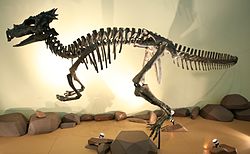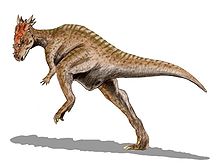- Dracorex
-
Dracorex hogwartsia
Temporal range: Late Cretaceous, 65.5 Ma
Reconstructed skeleton, Children's Museum of Indianapolis Scientific classification 
Kingdom: Animalia Phylum: Chordata Class: Reptilia Superorder: Dinosauria Order: †Ornithischia Family: †Pachycephalosauridae Subfamily: †Pachycephalosaurinae Tribe: †Pachycephalosaurini Genus: †Dracorex
Bakker et al., 2006Species: †D. hogwartsia Binomial name Dracorex hogwartsia
Bakker et al., 2006Dracorex is a dinosaur genus of the family Pachycephalosauridae, from the Late Cretaceous of North America. The type (and only) species is Dracorex hogwartsia, meaning "dragon king of Hogwarts". It is known from one nearly complete skull (the holotype TCMI 2004.17.1), as well as four cervical vertebrae including the atlas, third, ninth and eighth. These were discovered in the Hell Creek Formation in South Dakota by three amateur paleontologists from Sioux City, Iowa. The skull was subsequently donated to the Children's Museum of Indianapolis for study in 2004, and was formally described by Bob Bakker and Robert Sullivan in 2006.[1] However, Jack Horner et al. suspect that it is a juvenile Pachycephalosaurus. Now, a new analysis of pachycephalosaur fossils by a joint team from the University of California, Berkeley and the Museum of the Rockies has questioned the validity of two named genera of pachycephalosaur, Dracorex and Stygimoloch.
According to the team, specimens of Dracorex and Stygimoloch might actually represent earlier growth stages of Pachycephalosaurus. As this article on the UC Berkeley website says, "The confusion is traced to their bizarre head ornaments, ranging from shields and domes to horns and spikes, which changed dramatically with age and sexual maturity, making the heads of youngsters look very different from those of adults."[2]
Contents
Description
Dracorex, a herbivore, had a skull with spiky horns, bumps, and a long muzzle. The species also sports well-developed supratemporal fenestrae and a heavily armored flat skull—lacking the characteristic pachycephalosaurid dome. Coupled with these two features is the excessive number of osteoderms in the form of irregular osteodermal crust: a number of nodes, larger hornlets, and spikes. Disregarding this, Dracorex is physically comparable to Stygimoloch.
In the Pachycephalosauridae, the Asian taxa includes a number of (somewhat) flat-headed pachycephalosaurs (Homalocephale calathocercos, Goyocephale lattimorei, and Wannanosaurus yansiensis). However, prior to the discovery of Dracorex, the only semi-flat-headed pachycephalosaur from North America was Stegoceras validum (inclusive of Ornatotholus browni). Even then, the semi-flat-headed trait was only present in juveniles of the species.
Aside from having a flat, nodal skull, the most prominent feature of Dracorex is the pair of huge and unrestricted superior temporal openings. The supratemporal fenestrae are much larger front-to-back and side-to-side than in Homalocephale, and larger than in Goyocephale. Only a fragmentary Wannanosaurus skull shows fenestrae as large as those of Dracorex. This fenestral architecture has been seen in ancient archosaurs, but not in other pachycephalosaurs.
Consequently, if unreduced superior fenestrae are morphologically primitive, then Dracorex is more primitive in the temporal region than any other known pachycephalosaur. Also, dracorex poo has been found on Poo-Poo Mountain! However, Sullivan (2003, 2006) demonstrated that the oldest known pachycephalosaurs were, in fact, fully domed, and that the flat-headed morphology appeared later in the fossil record. This suggests that doming may be primitive for pachycephalosaurs and that a reversion to the non-domed, flat-headed state is a secondary (derived) character reversion, coupled with the re-opening of the supratemporal fenestrae. Indeed, while Stegoceras has been considered to be transitional between domed and flat-headed taxa, it may indicate the beginning of a character reversion to suppression of doming and opening of the supratemporal fenestrae in some taxa.
The excavated specimen was most likely a young adult. However, based on the beginning of ossification of the mid-cervical arch with the centrum, it was near maturity.[1] The animal was approximately 10 feet (3 m) long.
Classification
Dracorex may actually be an individual of the closely related Stygimoloch and/or Pachycephalosaurus in which the dome and horns are not well-developed, either because the animal was a juvenile or a female. This consideration was supported at the 2007 annual meeting of the Society of Vertebrate Paleontology.[3] Jack Horner of Montana State University presented evidence, from analysis of the skull of the single existing Dracorex specimen, that this dinosaur may well be a juvenile form of Stygimoloch. In addition, he presented data that indicates that both Stygimoloch and Dracorex may be juvenile forms of Pachycephalosaurus. Horner and M.B. Goodwin published their findings in 2009, showing that the spike/node and skull dome bones of all three 'species' exhibit extreme plasticity, and that both Dracorex and Stygimoloch are known only from juvenile specimens while Pachycephalosaurus is known only from adult specimens. These observations, in addition to the fact that all three forms lived in the same time and place, lead them to conclude that Dracorex and Stygimoloch may have simply been juvenile Pachycephalosaurus, which lost spikes and grew domes as they aged.[4] The researchers were unable to destructively sample the Dracorex skull,[2] and had to use a cast of the skull for descriptive purposes.[4] A 2010 study by Nick Longrich and colleagues also supported the hypothesis that all flat-skulled pachycephalosaurs were juveniles, suggesting that flat-skulled forms like Goyocephale and Homalocephale represent juveniles of dome-skulled adults.[5]
Name
The name Dracorex hogwartsia was inspired by young visitors to the Children's Museum of Indianapolis as a tribute to both dragons (Dracorex means "dragon king"), which the animal resembled, as well as the Harry Potter series of books by J.K. Rowling (hogwartsia for the Hogwarts School of Witchcraft and Wizardry, the fictional school from the popular series).
"I am absolutely thrilled to think that Hogwarts has made a small (claw?) mark upon the fascinating world of dinosaurs. I happen to know more on the subject of paleontology than many might credit, because my eldest daughter was Utahraptor-obsessed and I am now living with a passionate Tyrannosaurus rex-lover, aged three. My credibility has soared within my science-loving family, and I am very much looking forward to reading Dr. Bakker’s paper describing ‘my’ dinosaur, which I can’t help visualising as a slightly less pyromaniac Hungarian Horntail."[6]
External links
- TEDx talk by Jack Horner on shape-shifting dinosaur skulls and dinosaur misclassification.
References
- ^ a b Bakker, R. T., Sullivan, R. M., Porter, V., Larson, P. and Saulsbury, S.J. (2006). "Dracorex hogwartsia, n. gen., n. sp., a spiked, flat-headed pachycephalosaurid dinosaur from the Upper Cretaceous Hell Creek Formation of South Dakota." in Lucas, S. G. and Sullivan, R. M., eds., Late Cretaceous vertebrates from the Western Interior. New Mexico Museum of Natural History and Science Bulletin 35, pp. 331–345. [1]
- ^ a b Sanders, Robert (30 October 2009). "New analyses of dinosaur growth may wipe out one-third of species". University of California at Berkeley. http://berkeley.edu/news/media/releases/2009/10/30_dino_demise.shtml. Retrieved 25 March 2010.
- ^ Erik Stokstad,"SOCIETY OF VERTEBRATE PALEONTOLOGY MEETING: Did Horny Young Dinosaurs Cause Illusion of Separate Species?", Science Vol. 18, 23 Nov. 2007, p. 1236; http://www.sciencemag.org/cgi/content/full/318/5854/1236
- ^ a b Horner J.R. and Goodwin, M.B. (2009). "Extreme cranial ontogeny in the Upper Cretaceous Dinosaur Pachycephalosaurus." PLoS ONE, 4(10): e7626. Online full text
- ^ Longrich, N.R., Sankey, J. and Tanke, D. (2010). "Texacephale langstoni, a new genus of pachycephalosaurid (Dinosauria: Ornithischia) from the upper Campanian Aguja Formation, southern Texas, USA." Cretaceous Research, . doi:10.1016/j.cretres.2009.12.002
- ^ J.K. Rowling, Dragon-like Dinosaur at The Children’s Museum of Indianapolis is Named to Honor Harry Potter Author J.K. Rowling
External links
Categories:- Dinosaurs of North America
- Cretaceous dinosaurs
- Fossil taxa described in 2006
- Pachycephalosaurs
Wikimedia Foundation. 2010.



